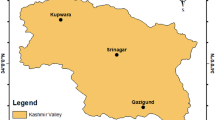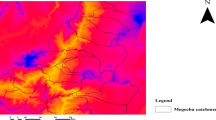Abstract
Reference evapotranspiration (ET0) is required to determine crop water requirements and irrigation scheduling. Many equations have been presented for determining ET0 using meteorological data, but in most of these equations weather stations are located in arid lands far away from agricultural areas, and therefore, the data are not valid for estimating ET0. Satellite images obtain data from vast agricultural areas. In this study, the FAO-56 Penman–Monteith equation was changed to a simple linear equation with three components, and for each component, a linear regression equation was fitted to NOAA satellite data. To establish regression models and their validity, 297 NOAA satellite images over 10 years (1999 to 2008) were used. The study area was Amir Kabir Agro-Industry Irrigation Network in Khuzestan province, Iran. Results showed that the simplified model proposed in this study, estimates ET0 with a determination coefficient of 0.92 and relative root mean square error of 8 %.




Similar content being viewed by others
References
Allen RG (1996) Assessing integrity of weather data for reference evapotranspiration estimation. J Irrig Drain Eng 122(2):97–106
Allen RG, Pereira LS, Raes D, Smith M (1998) Crop evapotranspiration. Guidelines for computing crop water requirements. In: FAO irrigation and drainage paper, no 56. FAO, Roma, Italy
Allen RG, Tasumi M, Trezza R (2007) Satellite-based energy balance for mapping evapotranspiration with internalized calibration (METRIC) – model. J Irrig Drain Eng 133(4):380–394
Ångström A (1924) Solar and terrestrial radiation. Q J R Meteorol Soc 50(2):121–126
Bastiaanssen WGM, Menenti M, Feddes RA, Holtslang AA (1998a) A remote sensing surface energy balance algorithm for land (SEBAL): 1. Formulation J Hydrol 212–213:198–212
Bastiaanssen WGM, Pelgrum H, Wang J, Ma Y, Moreno J, Roerink GJ, van der Wal T (1998b) The surface energy -balance algorithm for land (SEBAL): part 2. Validation J Hydrol 212–213:213–229
Blaney HF, Criddle WD (1962) Determining consumptive use and irrigation water requirements, USDA technical bulletin 1275. US Department of Agriculture, Beltsville
Bussieres N, Granger RJ, Strong GS (1997) Estimates of regional evapotranspiration using GOES-7 satellite data: Saskatchewan case study. Can J Remote Sens 23(1):3–14
Cambell JB (2002) Introduction to remote sensing. The Guilford Press New York
Caparrini F, Castelli F, Entekhabi D (2003) Mapping of land-atmosphere heat fluxes and surface parameters with remote sensing data. Bound-Layer Meteorol 107:605–633
Caparrini F, Castelli F, Entekhabi D (2004) Estimation of surface turbulent fluxes through assimilation of radiometric surface temperature sequences. J Hydrometeorol 5(1):145–159
Cleugh HA, Leuning R, Qiaozhen M, Running SW (2007) Regional evaporation estimates from flux tower and MODIS satellite data. Remote Sens Environ 106:285–304
Crow WT, Kustas WP (2005) Utility of assimilating surface radiometric temperature observations for evaporative fraction and heat transfer coefficient retrieval. Bound-Layer Meteorol 115:105–130
DehghaniSanij H, Yamamoto T, Rasiah V (2004) Assessment of evapotranspiration estimation models for use in semi-arid environments. Agric Water Manag 64(2):91–106
Dingman SL (1994) Physical hydrology. Macmillan Publishing Company New York, USA
Duffie JA, Beckman WA (1980) Solar engineering of thermal processes. Wiley, New York, USA
Elhag M, Psilovikos A, Manakos I, Perakis K (2011) Application of the sebs Water balance model in estimating daily evapotranspiration and evaporative fraction from remote sensing data over the Nile Delta. Water Resour Manag 25(11):2731–2742
Fisher JB, Tu KP, Baldocchi DD (2008) Global estimation of the land atmosphere water flux based on monthly AVHRR and ISLSCP-II data, validated at 16 FLUXNET sites. Remote Sens Environ 112(3):901–919
Fooladmand HR, Haghighat M (2007) Spatial and temporal calibration of Hargreaves equation for calculating monthly ETo based on Penman-Monteith method. Irrig Drain 56:439–449
French AN, Jacob F, Anderson MC, Kustas WP, Timmermans W, Gieske A, Su Z, Su H, McCabe MF, Li F, Prueger J, Brunsell N (2005) Surface energy fluxes with the advanced spaceborne thermal emission and reflection radiometer (ASTER) at the Iowa 2002 SMACEX site (USA). Remote Sens Environ 99:55–65
Gowda PH, Chavez JL, Colaizzi PD, Evett SR, Howell T, Atolk JA (2008) ET mapping for agricultural water management: present status and challenges. Irrig Sci 26(3):223–237
Hargreaves GH, Samani ZA (1985) Reference crop evapotranspiration from temperature. Appl Eng Agric 1(2):96–99
Jensen ME, Burman RD, Allen RG (1990) Evapotranspiration and irrigation water requirements. In: ASCE manuals and reports on engineering practice, no 70. ASCE, New York
John G, Yuan D, Lunetta RS, Elvidge CD (1998) A change detection experiment using vegetation indices. Photogram Eng Remote Sens 62:143–150
Julien Y, Sobrino JA, Verhoef W (2006) Changes in land surface temperatures and NDVI values over Europe between 1982 and 1999. Remote Sens Environ 103(1):43–55
Maeda EE, Wiberg DA, Pellikka PK (2011) Estimating reference evapotranspiration using remote sensing and empirical models in a region with limited ground data availability in Kenya. Appl Geogr 31:251–258
Makkink GF (1957) Testing the Penman formula by means of lysimeters. J Inst Water Eng 11(3):277–288
Menenti M, Choudhury BJ (1993) Parameterization of land surface evapotranspiration using a location dependent potential evapotranspiration and surface temperature range. In Proc. of exchange processes at the land surface for a range of space and time Scales, eds. H. J. Bolle et al. IAHS Pub. 212, 561–568. Wallingford, OX, UK.
Moran MS, Jackson RD (1991) Assessing the spatial distribution of evapotranspiration remotely sensed inputs. J Environ Qual 20(4):725–737
Norman JM, Anderson MC, Kustas WP, French AN, Mecikalski J, Torn R, Diak GR, Schmugge TJ, Tanner BCW (2003) Remote sensing of surface energy fluxes at 101-m pixel resolutions. Water Resour Res 39(8):1221. doi:10.1029/2002WR001775
Nishida K, Nemani RR, Glassy JM, Running SW (2003) Development of an evapotranspiration index aqua/MODIS for monitoring surface moisture status. IEEE T Geosciremote 41(2):493–501
Papadavid G, Hadjimitsis DG, Toulios L, Michaelides S (2013) A modified SEBAL modeling approach for estimating crop evapotranspiration in semi-arid conditions. Water Resour Manag 27(9):3493–3506
Penman HL (1948) Natural evaporation from open water, bare soil, and grass. Proc R Soc Lond A193:120–146
Priestley CHB, Taylor RJ (1972) On the assessment of surface heat flux and evaporation using large scale parameters. Mon Weather Rev 100:81–92
Rahimikhoob A, Behbahani MR, Fakheri J (2012) An evaluation of four reference evapotranspiration models in a subtropical climate. Water Resour Manag 26:2867–2881
Sheng JF, Wilson JP, Lee S (2009) Comparison of land surface temperature (LST) modeled with a spatially-distributed solar radiation model (SRAD) and remote sensing data. Environ Model Softw 24(3):436–443
Su Z (2002) The surface energy balance system (SEBS) for estimation of turbulent heat fluxes. Hydrol Earth Syst Sci 6:85–100
Tabari H, Talaee P (2011) Local calibration of the Hargreaves and Priestley-Taylor equations for estimating reference evapotranspiration in arid and cold climates of Iran based on the Penman-Monteith model. J Hydrol Eng 16(10):837–845
Tabari H, Grismer ME, Trajkovic S (2013) Comparative analysis of 31 reference evapotranspiration methods under humid conditions. Irrig Sci 31:107–117
Temesgen B, Allen RG, Jensen DT (1999) Adjusting temperature parameters to reflect well-watered conditions. J Irrig ASCE 125(1):26–33
Thornthwaite CW (1948) An approach towards a rational classification of climate. Geogr Rev 38:55–94
Turc L (1961) Estimation of irrigation water requirements, potential evapotranspiration: a simple climatic formula evolved up to date. Ann Agron 12:13–49(in French)
Wang K, Li Z, Cribb M (2006) Estimation of evaporative fraction from a combination of day and night land surface temperature and NDVI: A new method to determine the priestly–Taylor parameter. Remote Sens Environ 102(3–4):293–305
Conflict of Interest
We have no conflict of interest to declare.
Author information
Authors and Affiliations
Corresponding author
Rights and permissions
About this article
Cite this article
Alavi, S.A., Rahimikhoob, A. A Simple Model for Determining Reference Evapotranspiration Using NOAA Satellite Data: a Case Study. Environ. Process. 3, 479–493 (2016). https://doi.org/10.1007/s40710-016-0141-7
Received:
Accepted:
Published:
Issue Date:
DOI: https://doi.org/10.1007/s40710-016-0141-7




